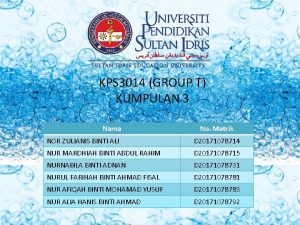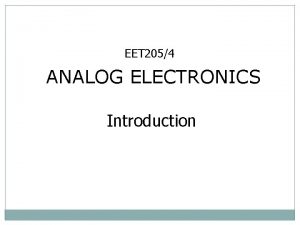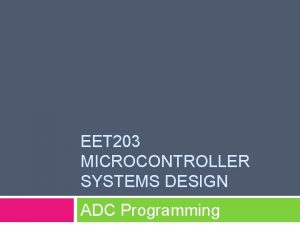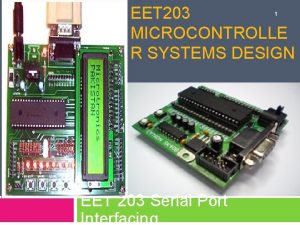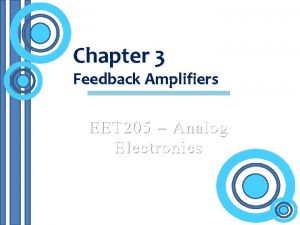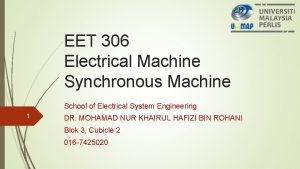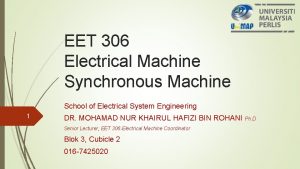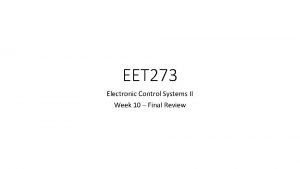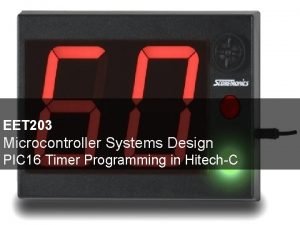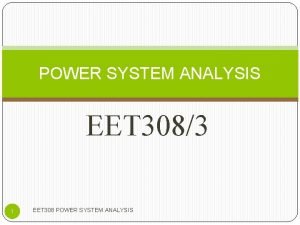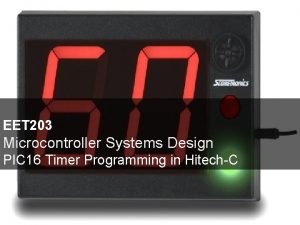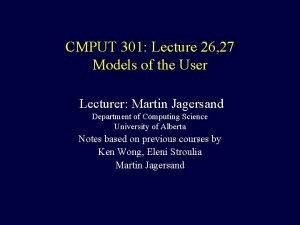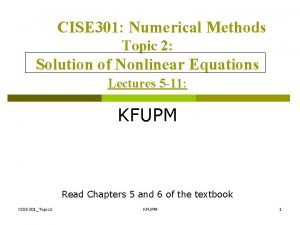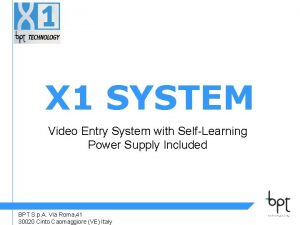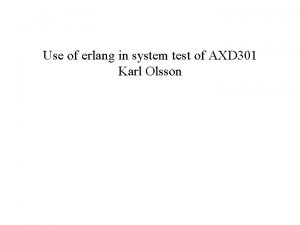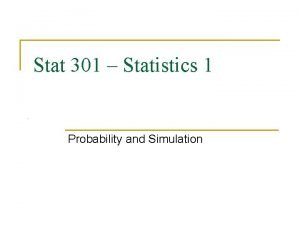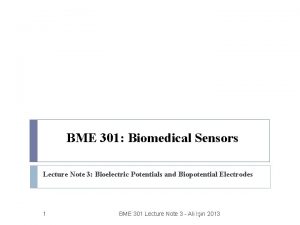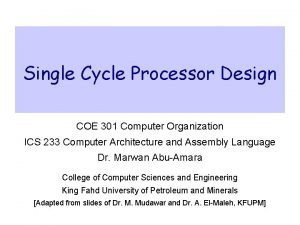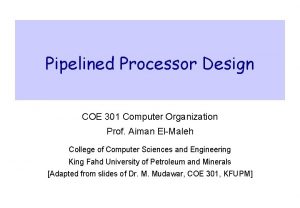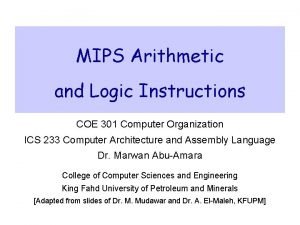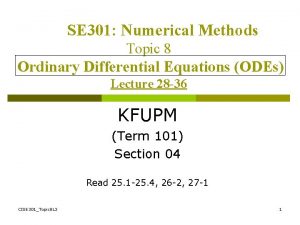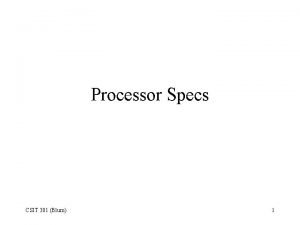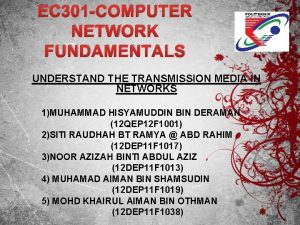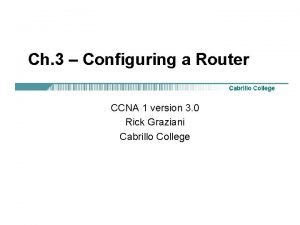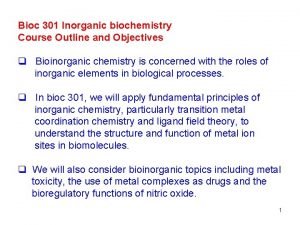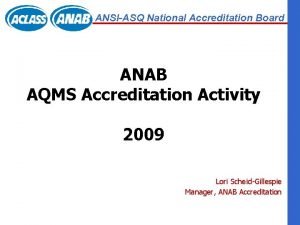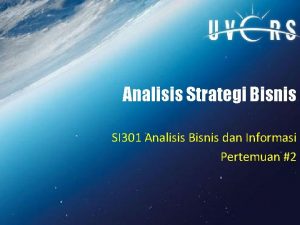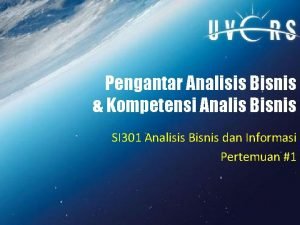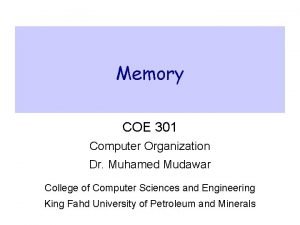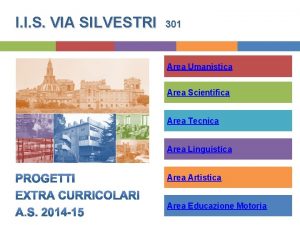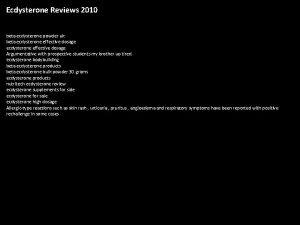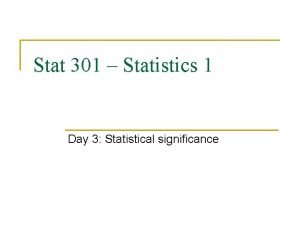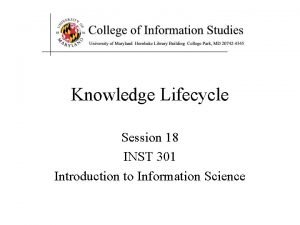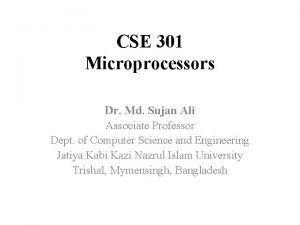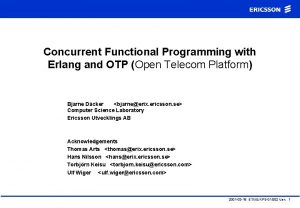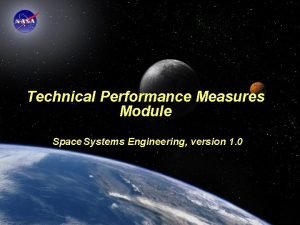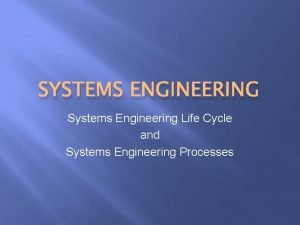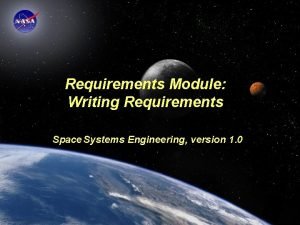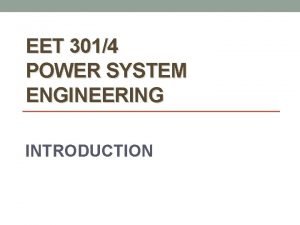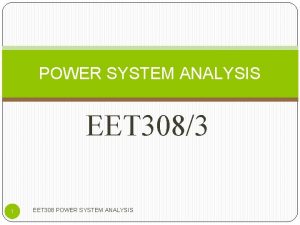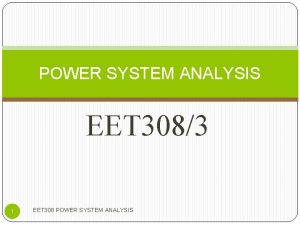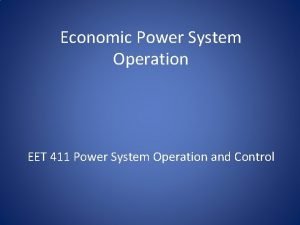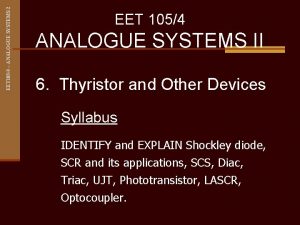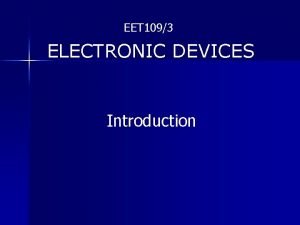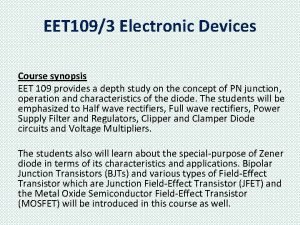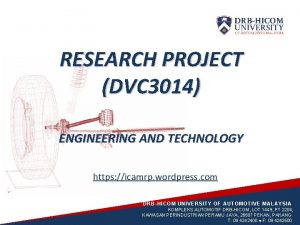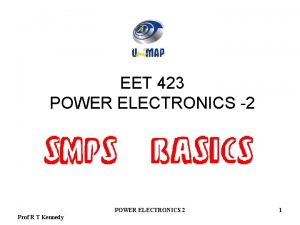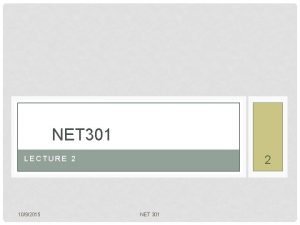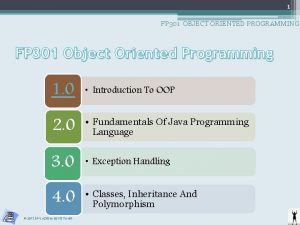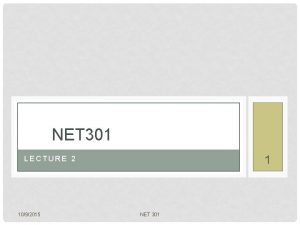POWER SYSTEM ENGINEERING EET 3014 1 EET 301










































































































- Slides: 106

POWER SYSTEM ENGINEERING EET 301/4 1 EET 301 POWER SYSTEM ENGINEERING

CHAPTER 7 PROTECTION IN POWER SYSTEM 2 EET 301 POWER SYSTEM ENGINEERING

On completion of this lesson, a student should be able to: Ability to explain and evaluate symmetrical fault and protection in power system 3 EET 301 POWER SYSTEM ENGINEERING

TOPIC OUTLINE 7. 1 7. 2 7. 3 7. 4 7. 5 7. 6 4 Introduction Basic Components of Protection System The Concept of Protection System Fuse Computer Relaying Zone of Protection EET 301 POWER SYSTEM ENGINEERING

INTRODUCTIO N 5 EET 301 POWER SYSTEM ENGINEERING

7. 1 INTRODUCTION The primary function of a protection system in an electrical power network is to ensure the continuity of the electricity supply. To achieve this, the protection system must be able to: q. Detect the abnormal condition in an electrical circuit or piece of equipment q. Identify the location of the fault q. Isolate the faulty section of the circuit or the faulty equipment only without the electricity supply to the rest of the network. 6 EET 301 POWER SYSTEM ENGINEERING

INTRODUCTION Requirements To Protective System Provide For Basis To Design Criteria Reliability: Operate dependably when fault conditions occur, even after remaining idle for months or years. Failure to do so may result in costly damages. Speed: Operate rapidly to minimize fault duration and equipment damage. Any intentional time delays should be precise. Selectivity: A relay system should provide maximum possible service continuity with minimum system disconnection. Simplicity: Minimize protection equipment and circuitry. Economy: Provide maximum protection at minimum cost. 7 EET 301 POWER SYSTEM ENGINEERING

BASIC COMPONENTS OF PROTECTION SYSTEM 8 EET 301 POWER SYSTEM ENGINEERING

7. 2 BASIC COMPONENTS Protection systems have 3 basic components: 1. Instrument transformers 2. Protective Relays 3. Circuit breakers A simple overcurrent protection schematic with: (1) one type of instrument transformer—the current transformer (CT), (2) An overcurrent relay (OC), and (3) a circuit breaker (CB) for a single-phase line. Figure 1: Overrcurrent Protection Schematic 9 EET 301 POWER SYSTEM ENGINEERING

10 EET 102 ELECTRIC CIRCUIT II

BASIC COMPONENTS 7. 2. 1 Instruments Transformer In general, there are 2 basic types of instruments transformers: Current Transformer (CT) Voltage Transformer (Potential Transformer) (VT) Figure 2 shows a schematic representation for the VT and CT. The transformer primary is connected to or into the power system and is insulated for the power system voltage. The VT reduces the primary voltage and the CT reduces the primary current to much lower, standardized levels suitable for operation of relays. 11 EET 301 POWER SYSTEM ENGINEERING

BASIC COMPONENTS Figure 2: VT and CT Schematic 12 EET 301 POWER SYSTEM ENGINEERING

BASIC COMPONENTS Currents Transformer (CT) For small currents at low voltage, trip coils and ammeter can be connected directly into the current, for example in series with the load. However, series connection is not practical for HV systems and for larger currents, for example 100 A and above. Current transformers are used as a link between the main circuit and the protection or measuring equipment. 13 EET 301 POWER SYSTEM ENGINEERING

BASIC COMPONENTS The function of the CT is to reproduce in its secondary winding a current I’ that is proportional to the primary current I. The CT converts primary currents in the kilo ampere range to secondary currents in the 0 -5 ampere range for convenience of measurement, with the following advantages. Safety: Instrument transformers provide electrical isolation from the power system so that personnel working with relays will work in a safer environment. Economy: Lower-level relay inputs enable relays to be smaller, simpler and less expensive. Accuracy: Instrument transformers accurately reproduce power system currents and voltages over wide operating ranges. 14 EET 301 POWER SYSTEM ENGINEERING

BASIC COMPONENTS Currents transformers are divided into 2 main types: Protection currents transformer Measuring current transformer The main parameters that define a current transformer are: Rated Primary Current: The maximum primary current that the transformer has been designed, for example the maximum current at which it can still comply with the relevant standard specifications. Rated Secondary Current: The maximum secondary current that transformer has been designed for. The values are usually 1 A or 5 A. Burden (in VA): The maximum load which can be connected to secondary of the transformer. Accuracy class: The designation given to a current transformer that complies with the error limits specified in the standards specification. 15 EET 301 POWER SYSTEM ENGINEERING

BASIC COMPONENTS Accuracy class In BS 3938: 1973, measuring CTs are divided into 5 P of 10 P. A CT marked “ 5 P 20” indicates that this is a protection CT with composite error of 5% which is applicable for currents up to 20 times the rated current. Special purpose CT are designated as Class X. Example: A CT with a specification of 800/5 A, 15 VA, Class 0. 5, means that the rated primary current is 800 A, the secondary current is 5 A (when primary is 800 A), the burden is 15 VA, and it is a measuring CTs with a current ratio error of 5% at the rated current. 16 EET 301 POWER SYSTEM ENGINEERING

BASIC COMPONENTS Currents transformer used in distribution system have a single-turn primary windings and multi-turn secondary windings The 2 most common types of current transformer are: The primary winding is a straight copper bar (round or rectangular) the secondary windings is wound round this bar. b) A round iron core which the secondary winding is wound. Also known as a ring CTs. This types usually used extensively in the low voltage systems. a) 17 EET 301 POWER SYSTEM ENGINEERING

CURRENT TRANSFORMER 18 EET 301 POWER SYSTEM ENGINEERING

BASIC COMPONENTS Table 1: Standard CT Ratios Current Ratios 19 50: 5 100: 5 150: 5 200: 5 250: 5 300: 5 450: 5 500: 5 600: 5 800: 5 900: 5 1000: 5 1200: 5 1500: 5 1600: 5 2000: 5 2400: 5 2500: 5 3000: 5 3200: 5 4000: 5 5000: 5 6000: 5 EET 301 POWER SYSTEM ENGINEERING

BASIC COMPONENTS Ideally, the CT secondary is connected to a current- sensing device with zero impedance, such that the entire CTs secondary current flows through the sensing device. In practice, the secondary current divides, with most flowing through the low-impedance sensing device and some flowing through the CT shunt excitation impedance. CT excitation impedance is kept high in order to minimize excitation current. An approximate equivalent circuit of a CT is shown in Figure 3, where: Z' = CT secondary leakage impedance Xe = (Saturable) CT excitation reactance ZB = Impedance of terminating device (relay, including leads) 20 EET 301 POWER SYSTEM ENGINEERING

BASIC COMPONENTS Figure 3: Current Transformer Equivalent Circuits 21 EET 301 POWER SYSTEM ENGINEERING

BASIC COMPONENTS Determine Current Transformer Performance The following procedure can be used to determine CT performance. Step 1 : Assume a CT secondary output current I’ Step 2: Compute E’=(Z’+ZB) I’ Step 3: Using E’, Find Ie from the excitation curve Step 4: Compute I = n(I’+ Ie) , note: n=CTs ratio Step 5: Repeat step 1 -4 for different value of I’, then plot I’ versus I 22 EET 301 POWER SYSTEM ENGINEERING

BASIC COMPONENTS CT Error CT error is the percentage difference between (I’+ Ie) and I’. Where, Ie=CT Secondary excitation current I’=CT Secondary output current 23 EET 301 POWER SYSTEM ENGINEERING

EXAMPLE 7. 1 Evaluate the performance of the multi-ratio CT in Figure 3 with a 100: 5 CT ratio, for the following secondary output currents and burdens: a) I’ = 5 A and ZB = 0. 5 ohm. b) I’ = 8 A and ZB = 0. 8 ohm. c) I’ = 15 A and ZB = 1. 5 ohm. Figure 3: Current Transformer Equivalent Circuits 24 EET 301 POWER SYSTEM ENGINEERING

EXAMPLE 7. 1 Figure 4: Excitation curve for a multi-ratio bushing CT 25 EET 301 POWER SYSTEM ENGINEERING

SOLUTION (a) STEP 1: I’ = 5 A STEP 2: From Figure 4, E’ = (Z’ + ZB)I’ = (0. 082 + 0. 5)(5) = 2. 91 V STEP 3: From Figure 4, Ie = 0. 25 A STEP 4: I = n (I’ + Ie) = (100/5) (5+0. 25) = 105 A CT error = 0. 25/5. 25 x 100% = 4. 8%. 26 EET 301 POWER SYSTEM ENGINEERING

SOLUTION 2. 91 V 0. 25 A Figure 4: Excitation curve for a multi-ratio bushing CT 27 EET 301 POWER SYSTEM ENGINEERING

SOLUTION (b) STEP 1: I’ = 8 A STEP 2: From Figure 4, E’ = (Z’ + ZB)I’ = (0. 082 + 0. 8)(8) = 7. 06 V STEP 3: From Figure 4, Ie = 0. 4 A STEP 4: I = n (I’ + Ie) = (100/5) (8+0. 4) = 168 A CT error = 0. 4/8. 4 x 100% = 4. 8%. 28 EET 301 POWER SYSTEM ENGINEERING

SOLUTION 7. 06 V 0. 4 A Figure 4: Excitation curve for a multi-ratio bushing CT 29 EET 301 POWER SYSTEM ENGINEERING

SOLUTION (c) STEP 1: I’ = 15 A STEP 2: From Figure 4, E’ = (Z’ + ZB)I’ = (0. 082 + 1. 5)(15) = 23. 73 V STEP 3: From Figure 4, Ie = 5 A STEP 4: I = n (I’ + Ie) = (100/5) (15+5) = 400 A CT error = 20/35 x 100% = 57. 1%. 30 EET 301 POWER SYSTEM ENGINEERING

SOLUTION 23. 73 V 5 A Figure 4: Excitation curve for a multi-ratio bushing CT 31 EET 301 POWER SYSTEM ENGINEERING

SOLUTION Note that for the 15 A secondary current in (c), high CT saturation causes a large CT error of 57. 1%. Standard practice is to select a CT ratio to give little less than 5 -A secondary output current at maximum normal load. From (a), the 100: 5 CT ratio and 0. 5 ohm burden are suitable for a maximum primary load current of about 100 A. 32 EET 301 POWER SYSTEM ENGINEERING

EXAMPLE 7. 2 An overcurrent relay set to operate at 8 A is connected to the multiratio CT with a 100: 5 CT ratio. Will the relay detect a 200 A primary fault current if the burden ZB is a) 0. 8 ohm b) 3 ohm 33 EET 301 POWER SYSTEM ENGINEERING

BASIC COMPONENTS Voltage Transformer (VT) It is not practical to manufacture meters and indicating lamps for direct operation on 3. 3 k. V, 6. 6 k. V, 22 k. V or higher voltages. Voltage transformer that steps down the high voltages to working voltages for example 120 V, 240 V and 415 V are used. The are 2 types of voltage transformer : Protection transformer Measuring transformer 34 EET 301 POWER SYSTEM ENGINEERING

BASIC COMPONENTS The variation of voltage is a electricity network usually very small ( 5%) so the operating range of a measuring voltage transformer is small compare with that of a measuring. However, if a fault occurs, the voltage drops to a very low value. Protection VT must be able to operate over a wide range from as low as 5% to 190% of the rated voltage. (Alternatively, a separate battery power supply unit is used for supply power to the protection system/gear – the voltage is normally 30 V d. c) 35 EET 301 POWER SYSTEM ENGINEERING

BASIC COMPONENTS There are 2 types of construction for voltage transformer: Electromagnetic transformers with primary and secondary windings. It is impregnated with synthetic resin. Normally used up to 66 k. V. Capacitor VT which uses two capacitors in a voltage divider arrangement. The voltage across one of the capacitor connected to the primary of an auxiliary wound-type transformer. The required voltage for the protection or measuring device is taken from the secondary of this auxiliary transformer. 36 EET 301 POWER SYSTEM ENGINEERING

VOLTAGE TRANSFORMER 37 EET 301 POWER SYSTEM ENGINEERING

BASIC COMPONENTS 7. 2. 2 Protective Relays The function of the relay is to discriminate between normal operation and fault conditions. The OC relay in Figure 1 has an operating coil which is connected to the CT secondary winding, and a set of contacts. When |I’| exceeds a specified "pickup" value, the operating coil causes the normally open contacts to close. When the relay contacts close, the trip coil of the circuit breaker is energized, which then causes the circuit breaker to open. 38 EET 301 POWER SYSTEM ENGINEERING

BASIC COMPONENTS Class of Measuring Relays 1. Current relay: Operate at predetermined threshold value of current. 2. Voltage relay: Operate at predetermined threshold value of voltage. 3. Power relay: Operate at predetermined threshold value of power. 4. Directional relay: Alternating current: Operate according to the phase relationship between alternating quantities. Direct current: Operate according to the direction of the current and are usually of the permanent-magnetic, moving-coil pattern 39 EET 301 POWER SYSTEM ENGINEERING

BASIC COMPONENTS 5. Frequency relays: Operate at a predetermined frequency. These include over frequency and under frequency relays. 6. Temperature relays: Operate at a predetermined temperature in the protected component. 7. Differential relays: Operate according to the scalar or vectorial difference between two quantities such as current, voltage, etc. 8. Distance relays: Operate according to the "distance" between the relay's current transformer and the fault. The "distance" is measured in terms of resistance, reactance, or impedance. 40 EET 301 POWER SYSTEM ENGINEERING

BASIC COMPONENTS Electromechanical and Induction Disc Relays Two types of electromagnetic attraction type of relay are: 1. The plunger unit. It has cylindrical coils with an external magnetic structure and a center plunger. The plunger moves upward to operate a set of contacts when the current or voltage applied to the coil exceeds a certain value. 2. The clapper unit. It has a U-shaped magnetic frame with a movable armature across the open end. The armature is hinged at one side and spring-restrained at the other. 41 EET 301 POWER SYSTEM ENGINEERING

BASIC COMPONENTS When the electrical coil is energized, the armature moves toward the magnetic core, opening or closing a set of contacts with a torque proportional to the square of the coil current. 3. Induction disc relay Induction disc units are based on the watt-hour meter design and use the same operating principles. They operate by torque resulting from the interaction of fluxes produced by an electromagnet with those from induced currents in the plane of a rotatable aluminum disc. 42 EET 301 POWER SYSTEM ENGINEERING

BASIC COMPONENTS Keeper ф Disc IS Figure 5: Electromagnet Plunger type . ф. R Magnet plugs 6 Figure 7: Induction Disc Type Relay Unit. 2 3 1 1 magnetic core 2 armature 3 relay coil 4 spring 5 moving contact Bridge 6 normally open relay contact Figure 6: Electromagnet clapper type 43 Electromagnet . ф. L 5 4 Main coil I EET 301 POWER SYSTEM ENGINEERING

Induction Disc Relay This relay Inverse Definite Minimum Time (IDMT). The operating characteristic of a standard IDMT relay is defined as: TMS – time multiplier setting PSM – plug setting multiplier I – measured current Is – relay setting current 44 EET 301 POWER SYSTEM ENGINEERING

Induction Disc Relay Example: Determine the time of operation of a 1 A, 3 s overcurrent relay having a Plug Setting of 125% and a Time Multiplier of 0. 6. The supplying CT is rated 400: 1 A and the fault current is 4000 A. Solution the relay coil current for the fault The nominal relay coil current 45 EET 301 POWER SYSTEM ENGINEERING

Induction Disc Relay The plug setting multiplier the time of operation 46 EET 301 POWER SYSTEM ENGINEERING

BASIC COMPONENTS 7. 2. 3 Circuit Breaker (CB) CB is a reusable device that may be rest after operation. It set to protect circuit and equipment from over current resulting from overloads and short circuits. Electrically, CB connected in series with the load and carry load current under normal condition. Have three operation condition ON (Contact closed) allowing, load current to flow through breaker, OFF (Contact open) breaker contact open , circuit is deernergized and TRIPPED ( Contact open need reset) when overcurrent and overload occur or by the operation of the shunt trip on under voltage. 47 EET 301 POWER SYSTEM ENGINEERING

BASIC COMPONENTS Bimetal Circuit breaker contacts Current in Spring Latch Normal Current out A. Thermal Tripped Latch Circuit breaker contacts Current Spring out Armature Electromagnetic coil Current in Normal B. Magnetic Electromagnetic coil Tripped Figure 8: Circuit breaker trip mechanisms. 48 EET 301 POWER SYSTEM ENGINEERING

49 THE CONCEPT OF PROTECTION SYSTEM EET 301 POWER SYSTEM ENGINEERING

7. 3. 1 TRANSFORMER PROTECTION 50 A number of fault conditions can arise within a power transformer. Earth fault Core faults Inter turn faults Phase to phase faults Tank fault In addition to the fault condition cause stresses on the transformer, such as overloading, system faults , over voltages and under frequency operation EET 301 POWER SYSTEM ENGINEERING

TRANSFORMER PROTECTION PROTECTED APPARATUS I I im 1 im 2 Relay High impedance relay im 1 im 2 – im 1 im 2 Basic Differential Connections. Restricted Ground Fault Protection for a Y winding. The sum of the phase currents is balanced against the neutral current, hence the relay will not respond to fault outside the winding. 51 EET 301 POWER SYSTEM ENGINEERING Main scheme use for transformer. The main principle , the current at each side of protected apparatus for each phase are compared in differential relay. Any difference current will operate the relay.

TRANSFORMER PROTECTION PROTECTED APPARATUS I Number of considerations should be dealt with in applying differential protection including: - I im 1 im 2 Relay im 1 im 2 – im 1 im 2 Figure 9: Basic Differential Connections. 52 EET 301 POWER SYSTEM ENGINEERING § Transformer ratio The CT should have rating to match the rated currents of the transformer winding which they are applied. § The current transformer should be connected in Y for ∆ winding and ∆ for Y winding ( see next figure) §Allowance should be made for taping changing by providing restraining coil.

TRANSFORMER PROTECTION C. T. ’s Power transformer Circuit Breaker C. T. ’s A A B B C C Relay R R R 53 o o o R Phase A R Phase B R Phase C EET 301 POWER SYSTEM ENGINEERING Example of Differential Protection of a Δ/Y transformer.

EXAMPLE 7. 3 Consider a Δ/Y connected, 20 MVA, 33/11 k. V transformer with differential protection applied, for the current transformer ratios shown in Figure 10. Calculate the relay currents on full load. Find the minimum relay current setting to allow 125 percent overload. 54 EET 301 POWER SYSTEM ENGINEERING Figure 10

SOLUTION The primary line current is given by The secondary line current is 55 EET 301 POWER SYSTEM ENGINEERING

SOLUTION The C. T. current on the primary side is thus The C. T. current in the secondary side is Note that we multiply by to obtain the values on the line side of the Δ connected C. T. ’s. The relay current on normal load is therefore With 1. 25 overload ratio, the relay setting should be 56 EET 301 POWER SYSTEM ENGINEERING

TRANSFORMER PROTECTION Buchholz Protection it is common practice in transformer protection to employ gas-actuated relays for alarm and tripping. One such a relay is the Buchholz relay. Faults within a transformer will result in heating and decomposing of the oil in the transformer tank. The decomposition produces gases such as hydrogen, carbon monoxide, and light hydrocarbons, which are released slowly for minor faults and rapidly for severe arcing faults. In the gas activated relay named after its inventor, this phenomenon is utilized. 57 EET 301 POWER SYSTEM ENGINEERING

TRANSFORMER PROTECTION The relay is connected into the pipe leading to the conservator tank. 58 EET 301 POWER SYSTEM ENGINEERING ø As the gas accumulates, the oil level falls and a float F is lowered and operates a mercury switch to sound an alarm. ø Sampling the gas and performing a chemical analysis provide a means for classifying the types of fault.

TRANSFORMER PROTECTION Buchholz protection provides an alarm for a number of fault conditions including: 1. Inter turn faults or winding faults involving only lower power levels. 2. Core hot spots due to short circuits on the lamination insulation. 3. Faulty joints. 4. Core bolt insulation failure. Major faults resulting in tripping include severe earth or inter phase winding faults and loss of oil through leakage. 59 EET 301 POWER SYSTEM ENGINEERING

7. 3. 2 BUSBAR PROTECTION Bus bars are an essential link in the electric power system, and short circuits in their zone have to be interrupted in the shortest possible time. In distribution systems (6 -20 k. V) with supply through transformers, overcurrent time-relays provide an easy protection mechanism. The relays interrupt the supply to the bus bars if one or more supplies conducting a fault current. Power direction relays are used in the transformer supply side to respond to a fault at the bus bars. 60 EET 301 POWER SYSTEM ENGINEERING

BUSBAR PROTECTION Differential protection is the most reliable method of protection for bus bars. 61 EET 301 POWER SYSTEM ENGINEERING

7. 3. 3 GENERATOR PROTECTION There a number of abnormal conditions that may occur with rotating equipment, including: 1. Faults in the windings. 2. Loss of excitation. 3. Motoring of generators. 4. Overload. 5. Overheating. 6. Overspeed. 7. Unbalanced operation. 8. Out-of-step operation. 62 EET 301 POWER SYSTEM ENGINEERING

GENERATOR PROTECTION Various types of faults that may occur in the insulation system of a generator's windings. The faults shown are identified as: 1. Interphase short circuit. 2. Interturn fault. 3. Stator earth fault. 4. Rotor earth fault. 5. Interturn fault in rotor. Note that A denotes the insulation of individual windings and B denotes the stator core. 63 EET 301 POWER SYSTEM ENGINEERING

GENERATOR PROTECTION Allocation of Protective Devices for the Stator, Rotor and Prime Mover. 64 EET 301 POWER SYSTEM ENGINEERING

7. 3. 4 TRANSMISSION LINE PROTECTION It is necessary to provide the desired selectivity such that relay operation result in the least service interruption while isolating the fault. The excessive currents accompanying a fault are the basis of over current protection scheme. In transmission line protection system, it is necessary to provide the desired selectivity such that relay operation result in the least service interruption while isolating the fault. In transmission line protection scheme, relay coordination is MUST. 65 EET 301 POWER SYSTEM ENGINEERING

TRANSMISSION LINE PROTECTION Three methods of relay grading: Current Grading. Time Grading Inverse Time Over Current Relaying CURRENT GRADING 66 EET 301 POWER SYSTEM ENGINEERING 1. Operates at suitable graded current 2. Fault current are higher near the source. 3. Relays are set that decreases as distance from the source is increased.

TRANSMISSION LINE PROTECTION Time Grading 1. Ensure the breaker nearest to the fault open first, by choosing an appropriate time setting for each of the relay. 2. Time setting increase as the relay get closer to the source. Inverse Time Over Current Relaying 67 EET 301 POWER SYSTEM ENGINEERING 1. Evolved because of the limitation imposed by the use either current or time alone. 2. Time of operation is inversely proportional to the fault current level. Relays type CO-7 is in common use.

TRANSMISSION LINE PROTECTION Inverse Time Over Current Relaying q. The operating time over current relay varies with the current magnitude. q. There are two setting for this type of relay: 1. Pick-up current is determined by adjusted current coil tap setting (C. T. S). The pick-up current is the current that causes the relay to operate and close the contacts. 2. Time dial setting (or time multiplier setting) refers to the reset position of moving contact, and it is varies the time of operation at a given tap setting and current magnitude. 68 EET 301 POWER SYSTEM ENGINEERING

TRANSMISSION LINE PROTECTION Radial System Protection Many radial systems are protected by time delay overcurrent relays. Adjustable time delays can be selected such that the breaker closest to the fault opens, while other upstream breakers with larger time delays remain closed. That is, relays can be coordinated to operated in sequence so as to interrupt minimum load during faults. Successful relay coordination is obtained when fault currents are much larger than normal load currents Also, coordination of overcurrent relays usually limits the maximum number of breakers in a radial system to five or less, otherwise the relay closet to the source may have an excessive time delay 69 EET 301 POWER SYSTEM ENGINEERING

TRANSMISSION LINE PROTECTION Consider a fault at P 1 to the right of breaker B 3 for the radial system of Figure 10. We want breaker B 3 to open while B 2 and B 1 remains closed. Under these condition, only load L 3 is interrupted We could select a longer time delay for the relay at B 2 so that B 3 operates first Thus, for any fault to the right of B 3, B 3 provides primary protection If B 3 fails to open, B 2 will open after time delay, thus providing backup protection 70 EET 301 POWER SYSTEM ENGINEERING Figure 10

TRANSMISSION LINE PROTECTION Similarly, consider a fault at P 2, we want B 2 to open while B 1 remains closed Under these conditions, loads L 2 and L 3 are interrupted Since the fault is closer to the source, the fault current will be larger than for the previous fault considered We also select the B 1 relay with a longer time delay than B 2, so that B 2 opens first. Thus, B 2 provides primary protection for faults between B 2 and B 3, as well as back up protection for faults to the right of B 3. 71 EET 301 POWER SYSTEM ENGINEERING Figure 10

TRANSMISSION LINE PROTECTION Similarly, B 1 provides primary protection for faults between B 1 and B 2, as well as back up protection for further downstream faults The coordination time interval is the time interval between the primary and remote backup protective devices It is the different between the time that the backup relaying operates and the time that circuit breakers clear the fault under primary relaying Typical time interval between 0. 2 to 0. 5 seconds are selected to account in most practical applications 72 EET 301 POWER SYSTEM ENGINEERING Figure 10

EXAMPLE 7. 4 The CO-8 relay with a current tap setting of 6 amperes and time dial setting of 1 is used with the 100: 5 CT in Example 7. 1. Determine the relay operating time for each case. Solution: a) From example 7. 1(a) The relay does not operate. It remains in the blocking position. 73 EET 301 POWER SYSTEM ENGINEERING

SOLUTION b) Using curve 1 in Figure 11, toperating = 6 seconds c) From curve 1, toperating = 1. 2 seconds 74 EET 301 POWER SYSTEM ENGINEERING

Figure 11: CO-8 time delay overcurrent relay characteristic 75 EET 301 POWER SYSTEM ENGINEERING

EXAMPLE 7. 5 An 11 k. V, 50 Hz radial system is shown in Figure 12. Assuming a CO-7 relay with relay characteristic given in Figure 13 and the same power factor for all loads, select relay settings to protect the system with coordination time interval 0. 3 seconds. Figure 12 76 EET 301 POWER SYSTEM ENGINEERING

77 EET 301 POWER SYSTEM ENGINEERING Figure 13

SOLUTION The load currents are calculated as The normal current through the sections are then given by 78 EET 301 POWER SYSTEM ENGINEERING

SOLUTION With the given CT ratios, the normal relay currents are Now obtain C. T. S. (currents tap setting) or pick up current in such a way that the relay does not trip under normal currents. For this type of relay, C. T. S. available are 4, 5, 6, 7, 8, 10 and 12 A. 79 EET 301 POWER SYSTEM ENGINEERING

SOLUTION Choosing the nearest setting higher than the normal current For position 1, the normal current in the relay is 5. 25 A, so choose C. T. S. 1 = 6 A For position 2, the normal current in the relay is 8. 53 A, so choose C. T. S. 2 = 10 A For position 3, the normal current in the relay is 8. 69 A, so choose C. T. S. 3 = 10 A 80 EET 301 POWER SYSTEM ENGINEERING

SOLUTION Next, select the intentional delay indicated by TDS (Time Dial Setting). Utilize the short circuit currents to coordinate the relays The current in the relay at 1 on short circuit is Expressed as a pick up value Choose the lowest TDS for this relay for fastest action. Thus, TDS 1 = ½ 81 EET 301 POWER SYSTEM ENGINEERING

SOLUTION Referring to the relay characteristic, for TDS 1 = ½ and 10. 42 ratio, the operating time for the relay 1 for a fault at 1 is obtained as T 11 = 0. 15 s. To set the relay at 2 responding to a fault at 1, allow breaker operating time, Tbreaker = 5 cycle x 1/50 Hz = 0. 1 s. With coordination time 0. 3 seconds, thus primary protection to clear this fault T 21 = T 11+Tbreaker+Tcoordination = 0. 15 + 0. 1 + 0. 3 = 0. 55 s 82 EET 301 POWER SYSTEM ENGINEERING

SOLUTION Short circuit for a fault at 1 as a multiple of the CTs at 2 is From the characteristics for 0. 55 s operating time and 6. 25 ratio, TDS 2 = 2 Now setting the relay at 3 For a fault at bus 2, the short circuit current is 3000 A, for which relay 2 responds in a time T 22 calculated as 83 EET 301 POWER SYSTEM ENGINEERING

SOLUTION For TDS 2 = 2 and 7. 5 ratio, from relay characteristic, T 22 = 0. 5 s Allowing the same margin for relay 3 to respond for a fault at 2, as for relay 2 responding to a fault at 1, T 32 = T 22 + Tbreaker + Tcoordination = 0. 5 + 0. 1 + 0. 3 = 0. 9 s The current in the relay expressed as a multiple of pickup is Thus, for T 3 = 0. 9 s and 3. 75 ratio, from the relay characteristic TDS 3 = 2. 5 84 EET 301 POWER SYSTEM ENGINEERING

Jumaat 85 EET 102 ELECTRIC CIRCUIT II

FUSE 86 EET 301 POWER SYSTEM ENGINEERING

7. 4 FUSE Fuse is a device connected in series with the conductors that caries the full load current supplied to the load. Under the normal condition, the load current is less than the ampere rating of the fuse, and the fuse remain intact to connect the load to the source. When overload or short circuit occurs, the current through link will also increase. Once the link totally melted, an open circuit exist in the fuse, an open circuit exist and the circuit will remain open. Then it must be replaced. Fuse are “one time” device. 87 EET 301 POWER SYSTEM ENGINEERING

FUSE Reduced area of link Filler material A. Non-Current Limiting , Non-Time Delay Fuse Short circuit element Trigger spring Connector C. Current Limiting Time Delay Fuse 88 EET 301 POWER SYSTEM ENGINEERING B. Current Limiting Non-Time Delay Fuse

7. 4 FUSE During normal operation, when the fuse is operating below its continuous current rating, the resistance of the link is so low If an overload current occurs and persists for more than a short interval of time, the temperature of the link eventually reaches a level that causes a restricted segment of the link to melt. A gap is then formed an electric arc is established. As the arc causes the link metal to burn back, the gap width increases. The resistance of the arc eventually reaches such a high level that the arc cannot be sustained and it is extinguished. The current flow within the fuse is then completely cut off. 89 EET 301 POWER SYSTEM ENGINEERING

7. 4 FUSE 90 EET 301 POWER SYSTEM ENGINEERING

7. 4 FUSE Fuse specification is normally based on the following four factors. Voltage rating: this rms voltage determines the ability of a fuse to suppress the internal arc that occurs after the fuse link melts. A blown fuse should be able to withstand its voltage rating. Most low voltage fuse have 250 – 600 V rating and medium voltage rating fuse range from 2. 4 – 34. 5 k. V. Continuous current rating: the fuse should carry this rms current indefinitely, without melting and clearing. Interrupting current rating: Is the largest rms asymmetrical current that the fuse can safely interrupt. Standard interrupting rating for medium voltage include 65, 80 and 100 k. A. Time response: the melting and clearing time of a fuse depends on the magnitude of the overcurrent and specified by a ‘time-current’ curve. 91 EET 301 POWER SYSTEM ENGINEERING

Example A 415 V distribution system is shown in Figure 14. Select the suitable rating of fuse for each load and incoming circuit using fuse time-current characteristic in Figure 15. 92 EET 301 POWER SYSTEM ENGINEERING Figure 14

Example 93 EET 301 POWER SYSTEM ENGINEERING Figure 15

94 EET 301 POWER SYSTEM ENGINEERING Figure 15

Solution Fuse selection for each circuit Lighting load: select 32 A fuse Heating load: select 50 A fuse 95 EET 301 POWER SYSTEM ENGINEERING

Solution Motor load: The motor full load current is The starting current for 10 seconds is 7 time than the full load current, therefore 96 EET 301 POWER SYSTEM ENGINEERING

Solution From the time-current curve, an 80 A fuse would withstand 383 A for only 6 seconds. Therefore, for a 100 A fuse, which would withstand 383 A for longer than 10 seconds, would be necessary. To provide discrimination the fuse at incoming circuit must meet the following requirements: It must carry the normal load current: It must carry the load + the starting current of the motor From time-current curve, a 125 A fuse would withstand 452. 5 A for more than 10 s. 97 EET 301 POWER SYSTEM ENGINEERING

COMPUTER RELAYING 98 EET 301 POWER SYSTEM ENGINEERING

7. 5 COMPUTER RELAYING The electric power industry has been one of the earliest users of the digital computer as a fundamental aid in the various design and analysis aspects of its activity. There are many perceived benefits of a digital relaying system: 1. Economics: cost effective 2. Reliability: continuously active providing a high level of self-diagnosis. 3. Flexibility: Revisions or modifications made necessary by changing operational conditions 4. System interaction: The availability of digital hardware that monitors continuously the system performance at remote substations. 99 EET 301 POWER SYSTEM ENGINEERING

COMPUTER RELAYING Example of Functional Block of Digital Relay 100 EET 301 POWER SYSTEM ENGINEERING

ZONE OF PROTECTION 101 EET 301 POWER SYSTEM ENGINEERING

7. 6 ZONE OF PROTECTION Power system configurations, a fundamental concept is the division of a system into protective zones. If a fault occurs anywhere within a zone, action will be taken to isolate that zone from the rest of the system. Zones are defined for: Generators Transformers Buses Transmission and distribution lines Motors 102 EET 301 POWER SYSTEM ENGINEERING

ZONE OF PROTECTION Each zone is defined by a closed, dashed line. As shown in Figure 16, Zone 1 for example, contains a generator and connecting leads to a transformer , . In some cases a zone may contain more than one component. For example, Zone 3 contains a generator-transformer unit and connecting leads to a bus, and Zone 10 contains a transformer and a line. Protective zones have the following characteristics: Zones are overlapped. Circuit breakers are located in the overlap regions. For a fault anywhere in a zone, all circuit breakers in that zone open to isolate the fault. 103 EET 301 POWER SYSTEM ENGINEERING

ZONE OF PROTECTION Figure 16 : Power System Protective Zones 104 EET 301 POWER SYSTEM ENGINEERING

END OF CHAPTER 7 105 EET 301 POWER SYSTEM ENGINEERING

T H A N K Y O U 106 EET 305 POWER SYSTEM FUNDAMENTAL
 Pengurusan sumber kps
Pengurusan sumber kps Kps 3014
Kps 3014 Fsu cop 3330
Fsu cop 3330 Aoe 3014
Aoe 3014 Pengurusan bimbingan dan kaunseling
Pengurusan bimbingan dan kaunseling The real lesson 21
The real lesson 21 Computer based system engineering in software engineering
Computer based system engineering in software engineering Power angle curve in power system stability
Power angle curve in power system stability Eet tool
Eet tool Eet writing
Eet writing Eet205
Eet205 Waar leeft de koala
Waar leeft de koala English exit test uitm writing sample answer
English exit test uitm writing sample answer Eet 203
Eet 203 Eet 203
Eet 203 Eet 203
Eet 203 Eet 2023
Eet 2023 Eet205 notes
Eet205 notes Eet machine
Eet machine Eet machine
Eet machine Wat eet een koe
Wat eet een koe Eet
Eet Eet 203
Eet 203 Ohalu
Ohalu 1 eet
1 eet Plattegrond emc
Plattegrond emc Eet 203
Eet 203 Sa se imparta numarul 301
Sa se imparta numarul 301 Logaritma adalah
Logaritma adalah Coe 301 kfupm
Coe 301 kfupm Contul 301
Contul 301 Cmnalle/301
Cmnalle/301 Cmput 301
Cmput 301 Class 301
Class 301 When to stop iterations in bisection method
When to stop iterations in bisection method X** video
X** video Axd301
Axd301 Unr cse
Unr cse Infinera tm-301
Infinera tm-301 Stat 301
Stat 301 301 day
301 day Processor memory gap
Processor memory gap Vamos batalhar juntos pelejar
Vamos batalhar juntos pelejar Edu 301
Edu 301 Bme 301
Bme 301 Bio 301
Bio 301 Bbm301
Bbm301 Health and safety at work act engineering
Health and safety at work act engineering Coe 301
Coe 301 Coe 301
Coe 301 Jika log 5 = 0 699 nilai log 20 adalah
Jika log 5 = 0 699 nilai log 20 adalah Am pm artinya
Am pm artinya Mips mult
Mips mult Isa 301
Isa 301 Bme
Bme Grundfos mobile interface
Grundfos mobile interface Ccna 200-301 slides
Ccna 200-301 slides Log 3=0 477 dan log 2=0 301 nilai log 18=
Log 3=0 477 dan log 2=0 301 nilai log 18= Heun's method formula
Heun's method formula Perpat 301
Perpat 301 Si 301
Si 301 Comp 301
Comp 301 Ec 301
Ec 301 Hard disk 1 (301)
Hard disk 1 (301) Ccna 200-301 ppt slides download
Ccna 200-301 ppt slides download Bioc 301
Bioc 301 Bio 301
Bio 301 Anab-301
Anab-301 Si-301
Si-301 Voltalab pgz 301
Voltalab pgz 301 Etat 301
Etat 301 Makalah kompetensi analisis bisnis
Makalah kompetensi analisis bisnis Nur301 textbook notes
Nur301 textbook notes Coe 301
Coe 301 Iis silvestri
Iis silvestri Traceability
Traceability Ecdysterone uk
Ecdysterone uk Hard disk 301
Hard disk 301 Stat 301
Stat 301 Ppl 301
Ppl 301 Comp sci 301 uw madison
Comp sci 301 uw madison Dram 301
Dram 301 Inst 301
Inst 301 Hr 301
Hr 301 Chem 301 gas law simulator
Chem 301 gas law simulator Dr sujan ali
Dr sujan ali Conditional move assembly
Conditional move assembly Ericsson axd 301 technical information
Ericsson axd 301 technical information Forward engineering and reverse engineering
Forward engineering and reverse engineering Principles of complex systems for systems engineering
Principles of complex systems for systems engineering Engineering elegant systems: theory of systems engineering
Engineering elegant systems: theory of systems engineering Forward and reverse engineering
Forward and reverse engineering Nei electric power engineering
Nei electric power engineering Solar power satellites and microwave power transmission
Solar power satellites and microwave power transmission Actual power and potential power
Actual power and potential power Flex28024a
Flex28024a What is dispersive power of plane transmission grating
What is dispersive power of plane transmission grating Power of a power property
Power of a power property General power rule
General power rule Informsu
Informsu Power absorbed or delivered
Power absorbed or delivered Is earth open or closed system
Is earth open or closed system Respiratory digestive and circulatory system
Respiratory digestive and circulatory system Tpm system engineering
Tpm system engineering System engineering life cycle
System engineering life cycle Context models in software engineering
Context models in software engineering Requirements writing for system engineering
Requirements writing for system engineering

